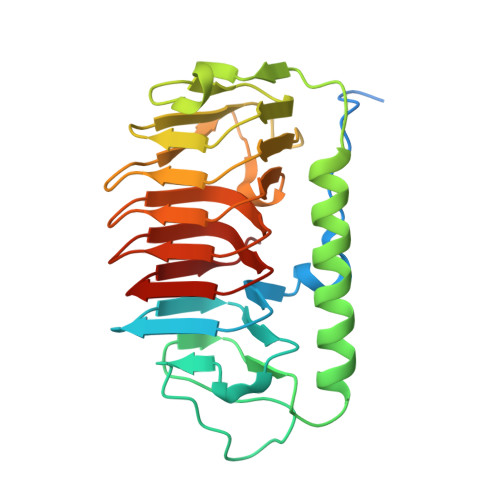Structure-based characterization and antifreeze properties of a hyperactive ice-binding protein from the Antarctic bacterium Flavobacterium frigoris PS1
Do, H., Kim, S.J., Kim, H.J., Lee, J.H.(2014) Acta Crystallogr D Biol Crystallogr 70: 1061-1073
- PubMed: 24699650
- DOI: https://doi.org/10.1107/S1399004714000996
- Primary Citation of Related Structures:
4NU2, 4NU3, 4NUH - PubMed Abstract:
Ice-binding proteins (IBPs) inhibit ice growth through direct interaction with ice crystals to permit the survival of polar organisms in extremely cold environments. FfIBP is an ice-binding protein encoded by the Antarctic bacterium Flavobacterium frigoris PS1. The X-ray crystal structure of FfIBP was determined to 2.1 Å resolution to gain insight into its ice-binding mechanism. The refined structure of FfIBP shows an intramolecular disulfide bond, and analytical ultracentrifugation and analytical size-exclusion chromatography show that it behaves as a monomer in solution. Sequence alignments and structural comparisons of IBPs allowed two groups of IBPs to be defined, depending on sequence differences between the α2 and α4 loop regions and the presence of the disulfide bond. Although FfIBP closely resembles Leucosporidium (recently re-classified as Glaciozyma) IBP (LeIBP) in its amino-acid sequence, the thermal hysteresis (TH) activity of FfIBP appears to be tenfold higher than that of LeIBP. A comparison of the FfIBP and LeIBP structures reveals that FfIBP has different ice-binding residues as well as a greater surface area in the ice-binding site. Notably, the ice-binding site of FfIBP is composed of a T-A/G-X-T/N motif, which is similar to the ice-binding residues of hyperactive antifreeze proteins. Thus, it is proposed that the difference in TH activity between FfIBP and LeIBP may arise from the amino-acid composition of the ice-binding site, which correlates with differences in affinity and surface complementarity to the ice crystal. In conclusion, this study provides a molecular basis for understanding the antifreeze mechanism of FfIBP and provides new insights into the reasons for the higher TH activity of FfIBP compared with LeIBP.
Organizational Affiliation:
Division of Polar Life Sciences, Korea Polar Research Institute, Incheon 406-840, Republic of Korea.
















